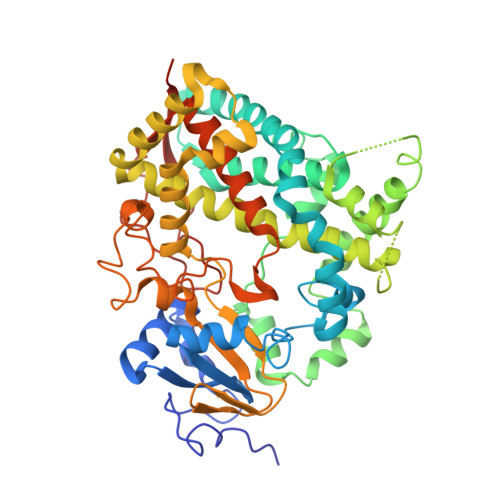Anion-Dependent Stimulation of Cyp3A4 Monooxygenase.
Sevrioukova, I.F., Poulos, T.L.(2015) Biochemistry 54: 4083
- PubMed: 26066995
- DOI: https://doi.org/10.1021/acs.biochem.5b00510
- Primary Citation of Related Structures:
5A1P, 5A1R - PubMed Abstract:
We co-crystallized human cytochrome P450 3A4 (CYP3A4) with progesterone (PRG) under two different conditions, but the resulting complexes contained only one PRG molecule bound to the previously identified peripheral site. A novel feature in one of our structures is a citrate ion, originating from the crystallization solution. The citrate-binding site is located in an area where the N-terminus splits from the protein core and, thus, is suitable for the interaction with the anionic phospholipids of the microsomal membrane. We investigated how citrate affects the function of a soluble CYP3A4 monooxygenase system consisting of equimolar amounts of CYP3A4 and cytochrome P450 reductase (CPR). Citrate was found to affect the properties of both redox partners and stimulated their catalytic activities in a concentration-dependent manner via a complex mechanism. CYP3A4-substrate binding, reduction of CPR with NADPH, and interflavin and interprotein electron transfer were identified as citrate-sensitive steps. Comparative analysis of various negatively charged organic compounds indicated that, in addition to alterations caused by changes in ionic strength, anions modulate the properties of CYP3A4 and CPR through specific anion-protein interactions. Our results help to better understand previous observations and provide new mechanistic insights into CYP3A4 function.
Organizational Affiliation:
Departments of †Molecular Biology and Biochemistry, ‡Chemistry, and §Pharmaceutical Sciences, University of California, Irvine, California 92697-3900, United States.

















